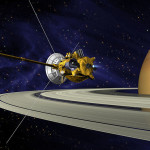Image: Public Domain, http://photojournal.jpl.nasa.gov/catalog/PIA08409
- The above is an actual mosaic image showing the heavily cratered surface of the northern hemisphere of Enceladus, moon of Saturn.
- At just over 300 miles across, Enceladus is a small moon, yet large in astrobiological promise. Its ancient, crater-marked northern surface belies the energetic, dynamic nature of it’s southern polar surface and interior; there, evidence strongly suggests a subsurface ocean of liquid water, under a thick layer of surface ice, and possibly heated (and thus prevented from freezing) by tidal flexing related to the force of gravity from Saturn.
- And the lie told by it’s northern surface even stands visibly

An artists conception of the Cassini-Huygens spacecraft in orbit around Saturn. Data from this spacecraft provides images of cryovolcanism on Enceladus, and strong evidence of a subsurface liquid water ocean. Image: public domain. Source: http://photojournal.jpl.nasa.gov/catalog/PIA03883. betrayed by the dramatic story of its southern polar region: imaging performed by the Cassini-Huygens spacecraft during a 2005 fly-by of Enceladus confirms active surface cryovolcanoes (“ice volcanos”) spewing geyser-like jets of massive amounts of icy particles and water vapor out at enormous speeds from its interior, beyond its surface, and into space.
- Recently mounting evidence suggests the presence of many of the “ingredients” required by known life in the likely subsurface ocean of Enceladus. In addition to the presence of stable, liquid water as a solvent for life, cryovolcanism and possible geologic activity increase available energy that could help drive life-friendly chemical reactions. Furthermore, simple organic molecules have been detected in the cryovolcano plumes, of types that, on Earth, support chemosynthetic microbes, such as methanogens (methane-producing microbes) that live near hydrothermal vents in Earth’s oceans.
© 2015 Fosdick EDS ☾><(((°>

